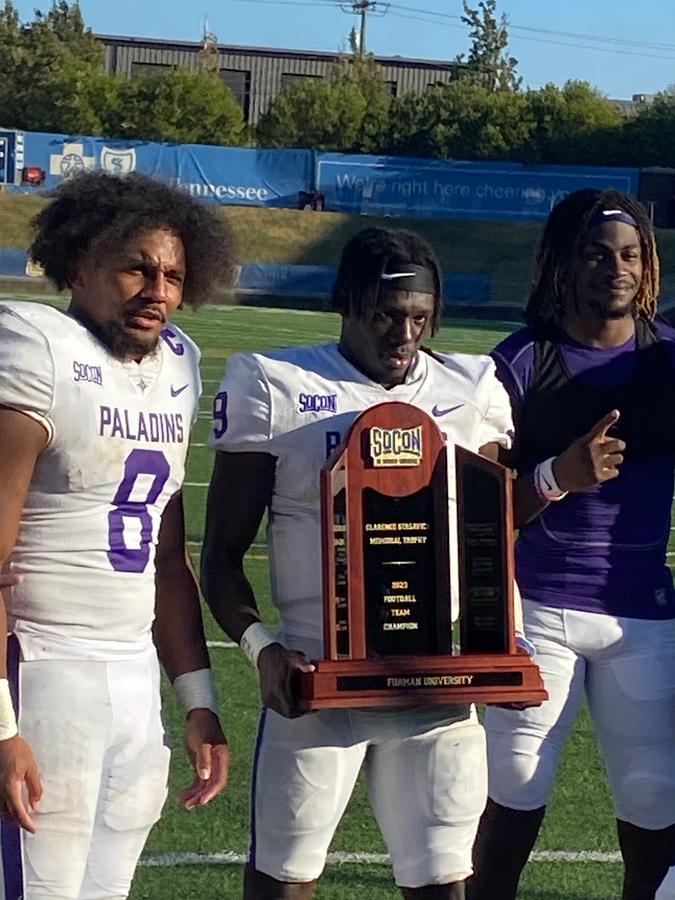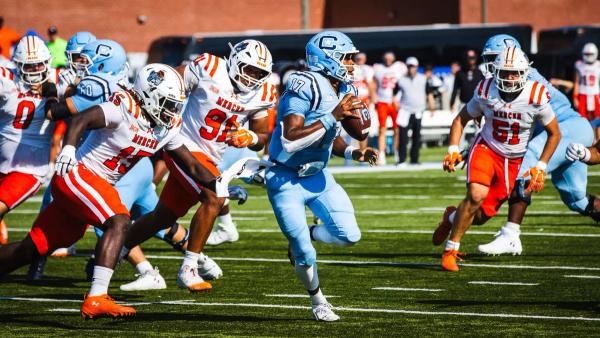•
Written By
Written By
•
•
•
Loading article...
Written By
Written By
Written By
John Hooper
Correspondent
Written By
John Hooper
Correspondent

When new commissioner Michael Cross took over as the Southern Conference commissioner, one of his first acts in his new position was dedicated to returning the Southern Conference to its traditional roots, which was by putting an emphasis back on football and changing how the league was referenced among its peers by the media.
Instead of being known as The SoCon, the future references to the league would be "The Southern Conference" setting the league’s brand apart as one of the oldest and one that helped grandfather in two of the greatest Power Five FBS leagues, the Atlantic Coast Conference and the Southeastern Conference.
On the gridiron, the football would follow the new commish’s lead. For the third straight season, the SoCon proved to be a formidable challenger nationally in the FCS postseason, with a team knocking at the door of being an FCS semifinal qualifier. It marked the third straight season the SoCon was able to get a team to the quarterfinals of the FCS playoffs, however, unlike the previous two seasons, the league garnered three postseason invites.
While the Southern Conference made some tremendous strides during the 2023 football season, a continued effort to change the narrative and perception of the league, which has been unfairly levied against the league by the national media since the departures of Appalachian State, Georgia Southern and Elon the league for good following the 2013 season.
Both App State and Georgia Southern moved on to the Sun Belt Conference, of course, while Elon made its decision to move to the CAA. Oh what a difference a decade has made.
The prevailing narrative and later, the perception formed was that the Southern Conference was a league that couldn’t compete with the "big boy" leagues of FCS football any longer. Those "big boy" leagues included the CAA, Missouri Valley Football Conference, and the Big Sky.
Now a decade later, the MVFC and Big Sky have done nothing to damage their perception in the national spotlight, however, the SoCon and the CAA are two conferences now headed in exactly the opposite directions.
Since James Madison won the national title in 2017, much has changed inside the CAA in terms of its overall strength. The league did manage to put a team in the semifinals of the FCS playoffs last season, however, as regular-season champion Albany surprised everyone to make it through to the semifinals, however, that felt more like an anomaly and a one-off performance from a very good Great Danes team than it did anything with the CAA being the conference it once was.
Following the 2021 season, James Madison announced it would be making the move to the FBS and the Sun Belt Conference the same way App State and Georgia Southern had done some seven years earlier. In fact, since James Madison briefly halted the Dakota States' (North and South Dakota) dominance over the FCS some seven years ago, the CAA has lost its top program to the FBS. Since then, the only other team to break up the FCS version of an unholy alliance is Sam Houston State during the COVID-19 compromised 2020 season. The Bearkats joined JMU at the FBS level shortly thereafter.
In mid-May, it was announced that longtime league member Richmond was on the move to the Patriot League in 2025, and Delaware has already made it known that the 2025-26 year will mark its move to the FBS. It’s unclear as of yet if there will be any more moves out of the CAA by the remaining members, however, rumors continue to abound.
For some reason, however, the national media has continued to hold the league in high regard, despite its obvious decline, while the perception of the Southern Conference has remained, with many looking at the league as one that has had its glory days long in the past.
Recent additions over schools like Bryant, Campbell, Hampton, Monmouth, Stony Brook and North Carolina A&T have done little to strengthen the CAA’s gridiron brand, and in fact, it remains a reason that current members are looking to re-align themselves away from the CAA.
The Southern Conference, meanwhile added Mercer, East Tennessee State and VMI back to its mix. Two of those three have already claimed league titles (ETSU in 2018 and ‘21) and VMI (2020), while Mercer, who re-started its program 11 years ago after a 72-year hiatus, broke through and made its first FCS playoff appearance, as well as won its first FCS playoff game in its history last fall.
In contrast to the SoCon's return to its roots and tradition, the CAA—now referred to as the "Coastal Athletic Association"—was formerly known as the "Colonial Athletic Association" before changing its conference distinction prior to the 2023 season, feels like its having more of an identity shift.
Sometimes change is good, but sometimes it's an effort to hide what’s really going. What's really going on with a league that has gone under the former conference distinctions such as the Yankee Conference, Atlantic 10, Colonial Athletic Association, and now Coastal Athletic Association, has seen teams move on from the league for one reason or another.
Now many wonder what will be the next domino to fall in the ever-changing world of conference re-alignment.
Will it be William & Mary? Maybe Elon? There is also some belief with the CAA losing ground as a basketball conference in recent seasons, and with the SoCon’s emergence as a strong mid-major league, some of the basketball-only programs like College of Charleston (once a SoCon member) and UNC Wilmington could be potential targets in the current cut-throat world of college athletics and conference re-alignment.
The SoCon feels like a strong, committed league all of the sudden. A decade ago, former commissioner of the time John Iammarino must have felt a little like Chicken Little, with all the chaos of teams leaving in both basketball (Davidson, College of Charleston, Elon, Georgia Southern and Appalachian State) and football (Elon, Appalachian State and Georgia Southern), however, the addition and re-additions of East Tennessee State, VMI and Mercer have proven to be a steadying presence on both fronts.
The SoCon also has a two million dollar exit fee. That has been as important as anything in helping maintain its current membership.
Much of the CAA's chaos has been more recently, and it hasn’t been all in reaction to what it has lost, but more of a shrewd emphasis on increasing membership to increase its presence in the FCS playoffs.
It’s no secret that increasing membership to 14 or 15 teams can allow for protected scheduling, allowing the league office to make out its composite league slate by protecting its perennial best teams, or the teams most likely to compete for a league title and a deep FCS playoff run in the preseason by limiting the games between the league’s strongest teams. That can, in turn, allow for more playoff qualifiers.
In a traditional sense, the SoCon’s way of doing things--with everyone facing each other in the always-tough league gauntlet — is the honorable way to do things. It’s also self-limiting as a conference. There’s no reward for everyone playing each other, but rather, it’s a mark against you and can cost you a playoff spot.
However, with Richmond’s announced departure in mid-May, it feels like the SoCon is ready to take their place as one of FCS football’s top three leagues once again, joining the Missouri Valley and the Big Sky in that respect. Since 2014, every current FCS member that has won a national title is from the Missouri Valley Football Conference.
The 2024 season feels like the timing is right for the Southern Conference to further strengthen its argument as one of the top three leagues in FCS football. Let see if the respect will finally follow suit from the national media.
The Southern Conference is in as good of a place as it could be given the circumstances currently in the ever-changing world of college athletics.
But like any league, it’s not perfect. Many will point to not being able to transfer and be eligible immediately like every other league now allows in NCAA Division I athletics, however, changing that rule would make little if any difference. It’s a rare exception to see those that want to transfer actually wish to stay in the league unless their previous coach takes a job at another league school. When that happens, in one way or another it seemingly almost involves VMI.
With that said, since Georgia Southern, App State and Elon left following the 2013 season, the league has remained as stable as ever.
While the transfer rule may not be a big deal, consideration of some league additions in football has to be on the docket of talking points.
The Big Sky, Missouri Valley and especially the CAA have ensured multiple playoff bids each season by virtue of have so many teams within their respective memberships that it is impossible for every school to play each other. If you schedule that right at the league office, you can schedule around the top teams playing each other and thus, enhance playoff hopes before the season even kicks off.
The SoCon will have several opportunities to record victories over the CAA this season, with three of the league’s teams facing off against William & Mary, while league teams will also face Richmond, Elon and Campbell.

